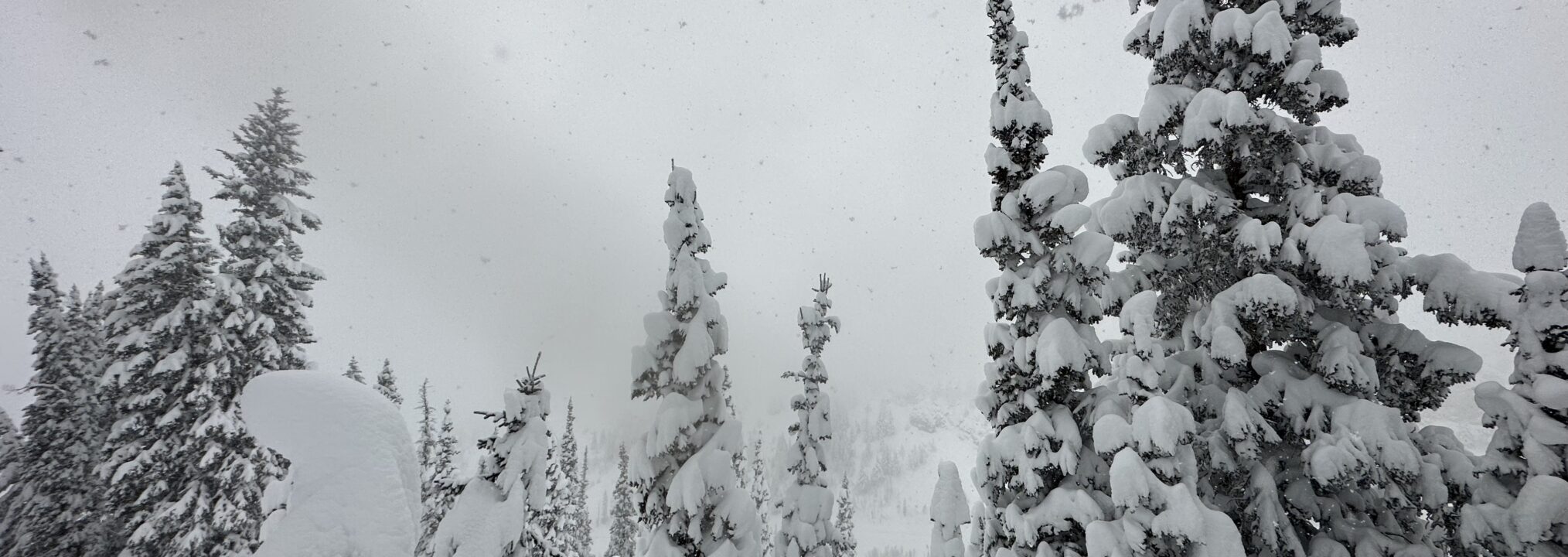We Don’t Need to Worry About Avalanches In-Bounds, Right?

March 6, 2024
Charlotte and I probably shouldn’t admit to this, but we love waking up to the sound of the Alta/Snowbird howitzers. While these big guns are being phased out (watch The Last Gunners for more on this), they are still relied on in an attempt to control avalanches in Little Cottonwood Canyon in Utah. Even with eyes and blinds mostly shut, a sharp stab of light typically pierces our vision when one of the guns goes off. The accompanying sound takes us the next step in the awakening process. The smaller blasts soon emanating directly from the ski areas tell us the patrol is up and about addressing the avalanche danger within the resorts. All this means one thing – it has snowed and snowed enough for avalanches to be an issue. Time to get up and analyze the day’s prospects.
On the one hand all this control work should probably be a cause for worry, right? If it really was safe to ski why the hell would they have to use guns and grenades? But, alas, that isn’t our typical focus. Most of us are happy not to go down that rabbit hole. Instead we take solace in our strong belief that once the patrol are done with the blasting it is completely safe for us ski within the bounds of the resorts. Not so fast!
The North American ski world received a meaningful wake up call on January 10th when an in-bounds avalanche fully buried 4 people and numerous other people were partially buried at Palisades Tahoe in California. Tragically, one skier was killed. There are several shocking aspects regarding this slide. It didn’t occur in the outer reaches of the resort but instead happened almost directly under the iconic KT-22 chairlift. The patrol had conducted control work in the area prior to it being opened. And the slide was massive – at least 450 ft. long, 100 ft. wide and left a debris pile at least 10 ft. deep. We have read many accounts of this event and perhaps the most comprehensive is in the Outside publication (piece can be read here: Outside/Palisades Tahoe Avalanche).
We suppose we shouldn’t be so shocked by the Palisades avalanche. There have been a number of in-bounds avalanches at well known western ski areas in recent years. In early December 2018 a large avalanche buried 5 skiers at Jackson, and in March of that year 5 people were caught in a significant slide at Palisades (then Squaw). While there were no fatalities in those cases a number of the skiers were hospitalized for their injuries. Two skiers at Taos were not so lucky. Taos put a chair up Kachina Peak in 2015, providing access to gnarly terrain that previously was only occasionally accessible by a significant hike. One of the steep chutes slid in January 2019 killing two skiers. See the Outside article for details and thoughts on that: Taos Avalanche.
The recent Palisades avalanche got us wondering more about this supposed unicorn – the in-bounds avalanche. Let’s just say the results of our research were sobering. Avalanches within the bounds of ski resorts are not rare. In the last 20 years numerous in-bounds avalanches have occurred resulting in 17 fatalities from 14 avalanches. Interestingly, there are some key commonalities in these events. Most significantly, many of these avalanches have occurred when the terrain has been recently opened for the first time in the year, mitigation has taken place by ski patrol and the avalanches have occurred when multiple people have previously been on the slope. Both the Palisades and the Taos avalanches fit this pattern. If you want a deep dive into the analysis of in-bounds avalanche activity in recent decades see Characteristics of Inbounds Avalanche Fatalities at United States Ski Areas.
In light of all this, what to do? First of all many skiers need not worry about this since they don’t ski in avalanche prone terrain – think steep terrain that looks like it should be out of bounds. But for those of us that relish such terrain, we need to be cautious and as the price of admission to ski these areas we should make an investment. Take an avalanche course even if you don’t ever plan on skiing outside the resorts. It’s only two days out of your life. You will learn basic rescue skills, and you will will become attuned to key danger signs. And then there is this. At the end of my avalanche course one of our instructors made us promise that even if skiing in-bounds that when there was a foot of new snow we would wear our beacons and when there was 18 inches of new snow we would also wear our avi packs. Worth the extra gear on those powder days. And while it is a little weird to think this way, if an area of a resort has just opened for the first time, give some consideration as to how dangerous that terrain really is.
Be Well; Ski Well

